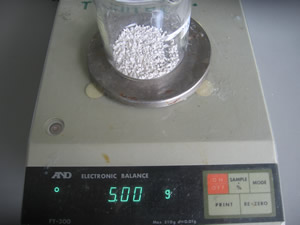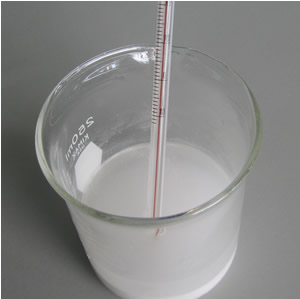Sports Science
Anhydrous copper sulfate and
water
Exothermic reaction
We will investigate the reaction between anhydrous copper sulfate and water.
Apparatus :
-50ml measuring cylinder
-100ml beaker
-electronic balance
-thermometer
-anhydrous copper sulfate
-resealable bags

Step 1- Measure 5 grams of anhydrous copper sulfate and place it in a 100 ml beaker.
Step 2- Measure 20 ml of water, using a measuring cylinder.
Step 3- Measure the temperature of the water using a thermometer.
Step 4- Pour the water into
the beaker containing the anhydrous copper sulfate and stir with the thermometer.

Step 5- Record the maximum temperature of the water.
Take care not to place the glass beaker on a metal surface as heat will escape.


Mass
of anhydrous copper sulfate |
Volume
of water |
Maximum
temperature |
| 5.0
grams |
10
ml |
|
| 5.0
grams |
20
ml |
|
| 5.0
grams |
40
ml |
|
| 5.0
grams |
60
ml |
|
| 5.0
grams |
80
ml |
Complete the table below
Mass
of anhydrous copper sulfate |
Volume
of water |
Maximum
temperature |
| 5.0
grams |
40
ml |
|
| 10.0
grams |
40
ml |
|
| 15.0
grams |
40
ml |
|
| 20.0
grams |
40
ml |
|
| 30.0
grams |
40
ml |
Graph the results shown in the tables above. Use proper labelling. Click for more information on graphs
Describe your
observations.
What happened to the temperature increase of the water as more water was
added to 5 grams of calcium oxide?
What happened to the temperature increase of the water as more anhydrous copper sulfate was added to 40 ml of water?
Consider your graphs. What mass of anhydrous copper sulfate must be added to 40 ml of water in order to increase the temperature of the water by 20oC?
Specific Heat
The specific heat is the amount of heat per unit mass required to raise
the temperature by one degree Celsius. The relationship between heat and
temperature change is usually expressed in the form shown below.
Heat added = specific heat X mass of water X temperature change
The specific heat of water is 4.2 joule/gram °C, which is higher than
any other every day substance. What this means is that, water can absorb
more energy than most substances before its temperature increases by one
degree Celsius. As a result, water plays a very important role in temperature
regulation.
Consider your table of values above. Calculate the amount of heat energy generated by the reaction when 10 grams of anhydrous copper sulfate is dissolved in 40 ml of water.